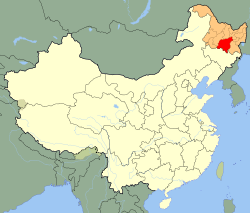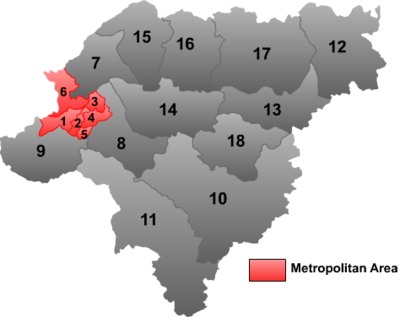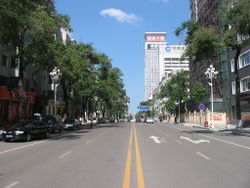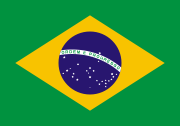Harbin
| Harbin 哈尔滨 ᡥᠠᡵᠪᡳᠨ |
|||
|---|---|---|---|
| — Sub-provincial city — | |||
| 哈尔滨市 | |||
 |
|||
|
|||
| Nickname(s): Ice City, Oriental Paris, Oriental Moscow | |||
 |
|||
| Coordinates: | |||
| Country | China | ||
| Province | Heilongjiang | ||
| County-level divisions | 19 | ||
| Government | |||
| - Secretary Municipal Committee of the CPC | Gai Ruyin 盖如垠 (since August , 2009) | ||
| - Mayor | Zhang Xiaolian 张效廉 (since February, 2007) | ||
| Area | |||
| - Sub-provincial city | 53,068 km2 (20,489.7 sq mi) | ||
| - Urban | 7,086 km2 (2,735.9 sq mi) | ||
| Elevation | 150 m (488 ft) | ||
| Population | |||
| - Sub-provincial city | 9,873,743 | ||
| - Density | 186.1/km2 (481.9/sq mi) | ||
| - Urban | 4,754,753 | ||
| - Urban density | 671/km2 (1,737.9/sq mi) | ||
| Time zone | China Standard Time (UTC+8) | ||
| Postal code | 150000 | ||
| Area code(s) | 451 | ||
| License plate prefixes | 黑A | ||
| GDP (2008) | CNY 286.82 billion | ||
| - per capita | CNY 29,012 | ||
| Website | www.harbin.gov.cn | ||
| Harbin | |||||||||||||
|---|---|---|---|---|---|---|---|---|---|---|---|---|---|
| Chinese name | |||||||||||||
| Traditional Chinese | 哈爾濱 | ||||||||||||
| Simplified Chinese | 哈尔滨 | ||||||||||||
| Literal meaning | a place for drying fishing nets or laughter like coast |
||||||||||||
|
|||||||||||||
| Manchu name | |||||||||||||
| Manchu | ᡥᠠᡵᠪᡳᠨ | ||||||||||||
| Russian name | |||||||||||||
| Russian | Харби́н | ||||||||||||
Harbin (simplified Chinese: 哈尔滨; traditional Chinese: 哈爾濱; pinyin: Hāěrbīn; Wade–Giles: Ha-erh-pin; Mandarin pronunciation: [xɑ˥˥ɑɻ˩pin˥˥]; Russian Харби́н), is a sub-provincial city and the capital of the Heilongjiang Province in Northeast China. It lies on the southern bank of the Songhua River. Harbin is the tenth largest city in China (pop. 9.87 million), serving as a key political, economic, scientific, cultural and communications hub in Northeastern China.
Harbin is originally a Manchu word meaning "a place for drying fishing nets". Harbin has very cold winters and is often called "Ice City". Harbin is well-known for its beautiful ice sculptures in winter and plays an important part in China's trade with Russia. In the 1920s, Harbin was considered China's fashion capital as new designs from Paris and Moscow reached there first before arriving in Shanghai.[1] Harbin is also a potential candidate for the 2022 Winter Olympics.
Contents |
History
Human settlement in the Harbin area dates from at least 2200 BC (late Stone Age). It was formerly called Pokai.
The modern city of Harbin originated in 1898 from a small village, with the start of the construction of the Chinese Eastern Railway (KVZhD) by Russia, an extension of the Trans-Siberian Railway, shortcutting substantially the distance to Vladivostok and creating a link to the port city of Dalny (Dalian) and the Russian Naval Base Port Arthur.
Following the Russian defeat in the Russo-Japanese War (1904-5), Russia's influence declined, and several thousand nationals from 33 countries including the United States, Germany, and France moved to Harbin. Sixteen countries established consulates and set up several hundred industrial, commercial and banking companies in Harbin. The Chinese also established their own businesses in brewing, food and the textile industry. Harbin had established its status as the center of northeastern China and as an international metropolis.
In December 1918, during the Russian Civil War, defeated Russian White Guards and refugees retreated to the city: it then became a major centre of White Russian émigrés. The city became the largest Russian enclave outside Russia. The Jewish community was formed by Russian Jews and included a group of German Jews, who fled Nazi Germany in the late 1930s. Under the pro bono efforts by Japanese government officials, they later emigrated to several cities in western Japan, notably Kobe, to ensure their safety and prosperity and established the largest synagogue in Japan. The Russians established the Russian school system and published Russian language newspapers and journals.
With the establishment of Manchukuo, Japanese troops occupied Harbin on 4 February 1932. The city became main base of operations of the infamous Unit 731 which was responsible for some of the most grisly war atrocities in human history. In 1935 the Soviet Union sold the railway (KVZhD) to the Japanese, which resulted in the first exodus of Russian emigres from Manchuria and Harbin in particular. The bulk of the departing Russians went back to the Soviet Union, while a substantial number moved south to Shanghai or emigrated to the United States and Australia.
The Soviet Army took the city on 20 August 1945 and Harbin never came under the control of the Kuomintang, whose troops stopped 60 km short of the city. The city's administration was transferred by the departing Soviet Army to the Chinese People's Liberation Army in April 1946.
During the short occupation of Harbin by the Soviet Army (August 1945 to April 1946), thousands of Russian emigres who fled communism after the revolution, were forcibly moved to the Soviet Union. The rest of the European community (Russians, Germans, Poles, Greeks etc.) emigrated during the years 1950-54 to Australia, Brazil and the USA, or were repatriated to their home countries. By 1988 the original Russian community numbered just thirty, all of them elderly.
During the Cultural Revolution many foreign and Christian things were uprooted, such as the St. Nicholas church which was destroyed by Red Guards in 1966.
The eight Harbin counties originally formed part of Songhuajiang Prefecture (松花江地区), and became incorporated into Harbin on 11 August 1999, making Harbin a sub-provincial city.
Harbin once housed one of the largest Jewish communities in the far-east. It reached its peak in the mid 1920's when 20,000 European Jews lived in the city. Among them were the parents of Ehud Olmert, the former Prime-minister of Israel. In 2004 Ehud Olmert came to Harbin with an Israeli trade delegation to visit the grave of his grandfather.
A benzene plant situated upstream in the city of Jilin along the Songhua river exploded on 13 November 2005. Benzene levels reached more than 100 times normal levels, which led authorities in Harbin to shut off the water supply, and some residents left the city while others rushed to buy bottled water. After a few days the water supply was restored. The Harbin government originally declared to the public that the water supply was temporarily off while the supply system was checked. They also denied reports of a chemical leak, claiming that it was "just a rumour."[2]
Administrative divisions
The sub-provincial city of Harbin has direct jurisdiction over 8 districts (区 qu), 3 county-level cities (市 shi) and 7 Counties (县 xian). On August 15, 2006, Dongli District (动力区) merged with Xiangfang District (香坊区).
 |
||||||
| # | Name | Hanzi | Hanyu Pinyin | Population (2003 est.) | Area (km²) | Density (/km²) |
|---|---|---|---|---|---|---|
| 1 | Daoli District | 道里区 | Dàolǐ Qū | 670,000 | 479 | 1,399 |
| 2 | Nangang District | 南岗区 | Nángǎng Qū | 990,000 | 183 | 5,410 |
| 3 | Daowai District | 道外区 | Dàowài Qū | 610,000 | 257 | 2,374 |
| 4 | Xiangfang District | 香坊区 | Xiāngfáng Qū | 710,000 | 340 | 2,088 |
| 5 | Pingfang District | 平房区 | Píngfáng Qū | 160,000 | 94 | 1,702 |
| 6 | Songbei District | 松北区 | Sōngběi Qū | 190,000 | 736 | 258 |
| 7 | Hulan District | 呼兰区 | Hūlán Qū | 620,000 | 2,186 | 284 |
| 8 | Acheng District | 阿城区 | Àchéng Qū | 650,000 | 2,770 | 235 |
| 9 | Shuangcheng City | 双城市 | Shuāngchéng Shì | 810,000 | 3,112 | 260 |
| 10 | Shangzhi City | 尚志市 | Shàngzhì Shì | 620,000 | 8,895 | 70 |
| 11 | Wuchang City | 五常市 | Wǔcháng Shì | 970,000 | 7,512 | 129 |
| 12 | Yilan County | 依兰县 | Yīlán Xiàn | 390,000 | 4,672 | 83 |
| 13 | Fangzheng County | 方正县 | Fāngzhèng Xiàn | 230,000 | 2,993 | 77 |
| 14 | Bin County | 宾县 | Bīn Xiàn | 620,000 | 3,846 | 161 |
| 15 | Bayan County | 巴彦县 | Bāyàn Xiàn | 700,000 | 3,138 | 223 |
| 16 | Mulan County | 木兰县 | Mùlán Xiàn | 270,000 | 3,602 | 75 |
| 17 | Tonghe County | 通河县 | Tōnghé Xiàn | 230,000 | 5,755 | 40 |
| 18 | Yanshou County | 延寿县 | Yánshòu Xiàn | 270,000 | 3,226 | 84 |
Geography
Harbin is located in southern Heilongjiang, on the southeastern edge of the Songnen Plain (松嫩平原). The city centre also sits on the southern bank of the middle Songhua River. As the prefecture is rather large, its latitude ranges from 44°04′-46°40′, the longitude 125°42′-130°10. Neighbouring prefectures are Yichun to the north, Jiamusi and Qitaihe to the northeast, Mudanjiang to the southeast, Daqing to the west,and Suihua to the northwest. In the southwest is Jilin Province. The terrain of the city is generally flat, with an average elevation of around 150 metres (490 ft).
Climate
| Harbin | ||||||||||||||||||||||||||||||||||||||||||||||||||||||||||||
|---|---|---|---|---|---|---|---|---|---|---|---|---|---|---|---|---|---|---|---|---|---|---|---|---|---|---|---|---|---|---|---|---|---|---|---|---|---|---|---|---|---|---|---|---|---|---|---|---|---|---|---|---|---|---|---|---|---|---|---|---|
| Climate chart () | ||||||||||||||||||||||||||||||||||||||||||||||||||||||||||||
|
||||||||||||||||||||||||||||||||||||||||||||||||||||||||||||
|
||||||||||||||||||||||||||||||||||||||||||||||||||||||||||||
Under the Köppen climate classification, Harbin features a humid continental climate with hot, humid summers and very cold winters. Harbin's nickname of the "Ice City" is well-earned. Its winters brutally cold and at times windy, as the average monthly high in January only reaches −12.3 °C (10 °F). However, the city is dry and sunny during winter. Both spring and especially fall constitute short transition seasons. Summer is very warm, with an average monthly high temperature in July soaring to 28.0 °C (82 °F). The annual precipitation, at 524 mm (20.6 in), is heavily concentrated from May to September, as evidenced by July's total of 142.7 mm (5.62 in).
| Climate data for Harbin (1971-2000) | |||||||||||||
|---|---|---|---|---|---|---|---|---|---|---|---|---|---|
| Month | Jan | Feb | Mar | Apr | May | Jun | Jul | Aug | Sep | Oct | Nov | Dec | Year |
| Source: China Meteorological Administration [3] | |||||||||||||
Economy
While Dalian is considered the region’s shipping center and Shenyang its financial hub, Harbin is striving hard towards becoming the key trade and shopping center of the region. The city is located in one of the fastest growing regions in the world and can boast a number of advantages such as an abundance of natural resources, good transport system and plenty of human resources.[4]
In 2008, Harbin's GDP reached RMB286.82 billion, an increase of 13.2 percent over the previous year. Tertiary industry output remained the largest component of GDP reaching RMB140.04 billion, an increase of 13.9 percent from the previous year. The total value for imports and exports by the end of 2008 was US$3.64 billion.[5]
The soil in Harbin, called “black earth” is one of the most nutrient rich in all of China, making it valuable for cultivating food and textile-related crops. As a result, Harbin is China’s base for the production of commodity grain and an ideal location for setting up agricultural businesses. Harbin also has industries such as light industry, textile, medicine, foodstuff, automobile, metallurgy, electronics, building materials, and chemicals which help to form a fairly comprehensive industrial system. Harbin Power Equipment Group Company and Northeast Light Alloy Processing Factory are two key enterprises. Harbin is also known as the capital of “power manufacturing”; hydro and thermal power equipment manufactured here makes up one-third of the total installed capacity in China.[6]
Foreign investors seem upbeat about the city. The Harbin Trade and Economic fair, has been held for 17 years annually, cumulatively attracting more than 1.3 million exhibitors and visitors and resulting in contracts of over US$90 billion. Japanese, Russian and Eastern European nations are increasingly looking to North China and Harbin for investment. Foreign direct investment remains low, but is growing as a result of government efforts, with utilized FDI totaling US$570 million, up 28.1 percent, in 2008.[7]
Harbin is also home to Harbin Institute of Technology, one of China’s better known universities. Founded in 1920, the university has developed into an important research university focusing on engineering, with supporting faculties in the sciences, management, humanities and social sciences. The institute's faculty and students contributed to and invented China's first analog computer, the first intelligent chess computer, and the first arc-welding robot. Last year, research funding from the government, industry, and business sectors surpassed RMB1.13 billion, the second highest of any university in China.[8]

Economic Development Zones and Ports[9]
- Harbin Development Zone
- Harbin Economic and Technological Development Zone
- Harbin High and New Technological Development Zone
Harbin High-tech Zone was set up in 1988 and was approved by the State Council as a national development zone in 1991. It has a total area of 34 sqkm in the centralized parks, subdivided into Nangang, Haping Road and Yingbin Road Centralized Parks. The Nangang Centralized Park is designated for the incubation of high-tech projects and research and development base of enterprises as well as tertiary industries such as finance, insurance, services, catering, tourism, culture, recreation and entertainment, where the headquarters of large famous companies and their branches in Harbin are located; the Haping Road Centralized Park is a comprehensive industrial basis for the investment projects of automobile and automobile parts manufacturing, medicines, foodstuffs, electronics, textile; the Yingbin Road Centralized Park is mainly for high-tech incubation projects, high-tech industrial development.[10]
-
- Harbin Port
- Daqing High-tech Industrial Development Zone
Infrastructure
Harbin is one of the largest railway hubs in Northeast China. Five major railways (Jingha, Binsui, Binzhou, Binbei and Labin) meet here. Currently 138 trains terminate in or pass through Harbin daily, with trains available to Beijing, Shanghai, Tianjin, Guangzhou, Jinan and many other major cities in China.[11]
The Harbin Taiping International Airport is the second largest international airport in Northeast China. There are flights to/from more than 30 large and medium-sized cities, including Beijing, Tianjin, Shanghai, Guangzhou, and Hong Kong.[12]
There are more than 1,900 rivers in Heilongjiang, including the Songhua River, Heilongjiang River and Wusulijiang River, creating a convenient system of waterway transportation. Harbin harbor is one of eight inland ports in China and the largest of its type in Northeast China. Available from mid-April until the beginning of November, passenger ships sail from Harbin up the Songhua River to Qiqihar, or downstream to Jiamusi, Tongjiang, and Khabarovsk in Russia.[13]
Architecture

Called the Oriental St. Petersburg, Harbin is considered one of China's most beautiful cities. The city is well-known for its unique, Russian and European-influenced architecture.
Zhong Yang Street (Central Street, also known as Kitaiskaya St.), one of the main business streets in Harbin, is a perfect remnant of the bustling international business activities at the turn of the 20th century. The 1.4-km long street is a veritable museum of European architectural styles: Baroque and Byzantine façades, little Russian bakeries, French fashion houses, American eateries, and Japanese restaurants.
The Russian Orthodox church, Saint Sophia Cathedral, is also located in this central district of Daoli. St. Sophia took nine years to build and was completed in 1932. It has now been made into a museum as a showcase of the multi-cultural architecture of Harbin.
Many citizens believe that the Orthodox church damaged the local feng shui, so they donated money to build a Chinese monastery in 1921, the Ji Le Temple. There were more than 15 Russian Orthodox churches and two cemeteries in Harbin until 1949. Mao's Communist Revolution, and the subsequent Cultural Revolution, saw many of them destroyed. Now, about 10 churches remain, while services are held only in one (Church of the Intercession in Harbin).
Culture
The Harbin local culture is based on Han culture, combined with Manchu culture and Russian culture. This combination of cultures influences the local architecture style, food, and customs. Harbin is famous for its standard Mandarin pronunciation, and is therefore considered a very good place to study Mandarin. As the saying goes, 'If you want to study Chinese, go to China. If you want to study Mandarin, go to Beijing. If you want to study standard Mandarin, go to Harbin.'
Russian influence
Harbin today is still very much influenced by its Russian past. A city once under Russian rule, it is now a center of trade with that country.
The influence of Russia came with the construction of the China Far East Railway, an extension of the Trans-Siberian Railway, and Harbin, known formerly as a fishing village began to prosper as the largest commercial, economic center of North Eastern Asia.
Tsarist Russia encouraged Russian settlement in their important Trans-Siberian-Railway outpost by waiving the then 25 year long military service. For Jews who settled there, the restrictions applying in Russia were also waived.
The local cuisine in Harbin is also Russian-influenced. Harbin's bakeries are famous for their bread (lie-ba in local dialect, derived from the Russian word khleb for "bread"). Harbin's sausages (qiu-lin hong-chang) are another notable product, in that they tend to be of a much more European flavour than other Chinese sausages.
Winter culture
Harbin is located in Northeast China under the direct influence of the cold winter wind from Siberia. The average temperature in summer is 21.2 degrees Celsius, −16.8 degrees Celsius in winter.
The annual Harbin International Ice and Snow Sculpture Festival has been held since 1985. Although the official start date is January 5 each year, in practice, many of the sculptures can be seen before. While there are ice sculptures throughout the city, there are two main exhibition areas: Enormous snow sculptures at Sun Island (a recreational area on the opposite side of the Songhua River from the city) and the separate "Ice and Snow World" that operates each night. Ice and Snow World features illuminated full size buildings made from blocks of ice. Winter activities in the festival include Yabuli Alpine Skiing, winter-swimming in Songhua River, and the ice-lantern exhibition in Zhaolin Garden. Snow carving and ice and snow recreations are world famous.
The "Harbin International Ice and Snow Festival" is one of the world's four largest ice and snow festivals, along with Japan's Sapporo Snow Festival, Canada's Quebec City Winter Carnival, and Norway's Ski Festival.
Every November, the city of Harbin sends teams of ice artisans to the United States to promote their unique art form. It takes more than 100 artisans to create ICE!, the annual display of indoor Christmas-themed ice carvings in Nashville, Tennessee; Kissimmee, Florida; and Grapevine, Texas.
Winter sports
The third Winter Asian Games took place in Harbin in 1996. The city of Harbin bid for hosting the 2010 Winter Olympics. The Alpine skiing events would have taken place in the Yabuli ski resort. In the frame of this campaign to assert its role on the world scene, Harbin was the host city of the 2009 Winter Universiade. Harbin planned to spend US$ 1.5 billion in construction and renovation of its sport infrastructure for this Universiade. Harbin also bid for the 2012 Winter Youth Olympics, but was passed over so still has its sights on the Olympics, perhaps in 2022.
Harbin has produced many world-class winter sports champions, including short track star and six-time Olympic medalist Wang Meng, 2006 pairs figure skating silver medalists Zhang Dan and Zhang Hao[14] and 2010 Vancouver Olympics figure skating gold medalists Shen Xue and Zhao Hongbo.

Harbin Summer Music Concert
Harbin Summer Music Concert ('Concert' for short) is a national concert festival, which is held on August 6 every two years for a period of 10~11 days. During the concert, multiple evenings, concert, race and activities are held. The artists come from all over the world. The 'Harbin Summer Music Month', which was then renamed as 'Harbin Summer Music Concert', was held in August 1958. The first formal Concert was held on August 5, 1961 in Harbin Youth Palace, and kept on every year until 1966 when the Cultural Revolution started in China. In 1979, the Concert was recovered and from 1994, it has been held every two years. In 2008, the 29th Harbin Summer Music Concert was held on August 6.
Media
The Heilongjiang Television and Harbin Economy Radio both serve as the media outlets of this region.
Transportation

Railway
Harbin Railway-Bureau is the first one in Chinese History, of which the railway density is the highest in China. Harbin Railway Station is one of the three modernized railway-networks.
Highway
Harbin has an advanced system of highways. Food and other products are shipped on these roads. The highways in Harbin have a big impact on the way of life, despite the fact that most are tolled.
There are seven important highways which pass through or terminate in Harbin, including the Beijing-Harbin, the Heihe-Dalian, the Harbin–Tong River, Changchun-Harbin, and the Manzhouli–Suifen River highways.[15]
- China National Highway 221
Airport
Harbin Taiping International Airport serves Harbin and is an important transportation hub for northeastern China. It is the largest northernmost airport of China and its terminal building (along with Shenyang-Taoxian Airport) is currently one of the largest in northeastern China. The technical level of flight district is 4E, which allows all kinds of large and medium civil aircraft. There are flights to over thirty cities including Beijing, Tianjing, Shanghai, Nanjing, Qingdao, Wenzhou, Xiamen, Guangzhou, Shenzhen, Shenyang, Dalian, Xi'an and Hong Kong. In addition there are also scheduled flights between Harbin and Hong Kong, Russia and South Korea.
Subway
Construction of Harbin Subway started on 5 December 2006. The total investment for the first phase is RMB5.89 billion. Twenty stations will be set on this 14.4 km long line starting from Harbin East Railway Station to the 2nd Affiliated Hospital of Harbin Medical University in the west of the city. A subway depot, a command center and two transformer substations will be built along the line. Most of the subway's route follow the air defence evacuation Tunnel left from the World War II.
Ports and Waterways
There are more than 1,900 rivers in Heilongjiang, including the Songhua River, Heilongjiang River and Wusulijiang River, creating a convenient system of waterway transportation. Harbin harbor is one of eight inland ports in China and the largest of its type in Northeast China. Available from mid-April until the beginning of November, passenger ships sail from Harbin up the Songhua River to Qiqihar or downstream to Jiamusi, Tongjiang and Khabarovsk (Russia).[15]
Colleges and universities


- Northeast Forestry University
- Harbin Institute of Technology
- Harbin Engineering University (former Harbin Shipbuilding Engineering Institute)
- Heilongjiang University
- Harbin Jewish Research Center
- Harbin Medical University
- Harbin Normal University
- Harbin University of Science and Technology
- Heilongjiang University of Chinese Medicine
- Heilongjiang Institute of Technology
- Heilongjiang East College
- Northeast Agricultural University
- Harbin Advance Technical College
- Harbin University of Commerce
International relations
Twin towns — Sister cities
Harbin is twinned with:
Domestic
- Chengdu, Sichuan
- Dalian, Liaoning
- Guangzhou, Guangdong
- Hangzhou, Zhejiang
- Wenzhou, Zhejiang
- Xiamen, Fujian
- Xining, Qinghai
- Nanjing, Jiangsu
International
 Niigata, Japan, since 1979
Niigata, Japan, since 1979 Aarhus, Denmark, since 1984
Aarhus, Denmark, since 1984 Edmonton, Canada, since 1985
Edmonton, Canada, since 1985 Sverdlovsk Oblast, Russia, since 1991
Sverdlovsk Oblast, Russia, since 1991 Minneapolis, United States, since 1992
Minneapolis, United States, since 1992 Anchorage, United States
Anchorage, United States Ekhuruleni, South Africa
Ekhuruleni, South Africa Warsaw, Poland, since 1993[16]
Warsaw, Poland, since 1993[16] Daugavpils, Latvia
Daugavpils, Latvia Khabarovsk, Russia
Khabarovsk, Russia Ploieşti, Romania
Ploieşti, Romania Asahikawa, Japan
Asahikawa, Japan Bucheon, South Korea
Bucheon, South Korea Salvador, Brazil
Salvador, Brazil Giv'atayim, Israel
Giv'atayim, Israel Griffith, Australia
Griffith, Australia Krasnodar, Russia
Krasnodar, Russia Cagayan de Oro City, Philippines, since 2007
Cagayan de Oro City, Philippines, since 2007 Rovaniemi, Finland
Rovaniemi, Finland Magdeburg, Germany, since 2008
Magdeburg, Germany, since 2008 Krasnoyarsk, Russia, since 2008
Krasnoyarsk, Russia, since 2008 Wiener Neustadt, Austria
Wiener Neustadt, Austria Yakutsk, Russia, since 2008[17]
Yakutsk, Russia, since 2008[17] Sunderland, United Kingdom (2009)[18]
Sunderland, United Kingdom (2009)[18] Fairfax County, United States (2010)[19]
Fairfax County, United States (2010)[19]
See also
- List of cities in the People's Republic of China by population
- List of current and former capitals of subnational entities of China
References
- ↑ China Briefing Business Guide: Harbin
- ↑ "Harbin: Truth emerges after secrecy". BBC News. 2005-11-23. http://news.bbc.co.uk/2/hi/asia-pacific/4464030.stm. Retrieved 2010-03-27.
- ↑ 3.0 3.1 "China Meteorological Data Sharing Service System" (in Simplified Chinese). China Meteorological Administration. http://cdc.cma.gov.cn/shuju/index3.jsp?tpcat=SURF&dsid=SURF_CLI_CHN_MUL_MMON_19712000_CES&pageid=3. Retrieved 2009-03-17.
- ↑ China Briefing Business Guide: Harbin Economy 1
- ↑ China Briefing Business Guide: Harbin Economy 2
- ↑ China Briefing Business Guide: Harbin Economy 3
- ↑ China Briefing Business Guide: Harbin Economy 4
- ↑ China Briefing Business Guide: Harbin Economy 5
- ↑ China Briefing Business Guide: Harbin Economic Development Zone
- ↑ RightSite.asia | Harbin New & Hi-Tech Industrial Zone
- ↑ China Briefing Business Guide: Harbin Infrastructure 1
- ↑ China Briefing Business Guide: Harbin Infrastructure 2
- ↑ China Briefing Business Guide: Harbin Infrastructure 3
- ↑ http://www.nbcolympics.com/athletes/athlete=2466/bio/index.html
- ↑ 15.0 15.1 "Dezan Shira & Associates". Dezan Shira & Associates. 2009. http://www.dezshira.com. Retrieved 2009-02-08.
- ↑ "Miasta partnerskie Warszawy". um.warszawa.pl. Biuro Promocji Miasta. 2005-05-04. http://um.warszawa.pl/v_syrenka/new/index.php?dzial=aktualnosci&ak_id=3284&kat=11. Retrieved 2008-08-29.
- ↑ Harbin and Yakutsk will be sister cities
- ↑ [1]
- ↑ [2]
- Thomas Lahusen. Harbin and Manchuria: Place, Space, and Identity. November 15, 2001. ISBN 0-8223-6475-1.
Further reading
- Meyer, Mike, "Manchuria Under Ice", Departures Magazine, Nov/Dec 2006, 292–297.
- Nikos Kavvadias, a popular Greek poet born in Harbin by Greek parents from Kefalonia, Greece
External links
- Harbin Government website
- Harbin travel guide from Wikitravel
|
|||||||||||||||
|
||||||||||||||||||||||
|
|||||
|
|||||||


